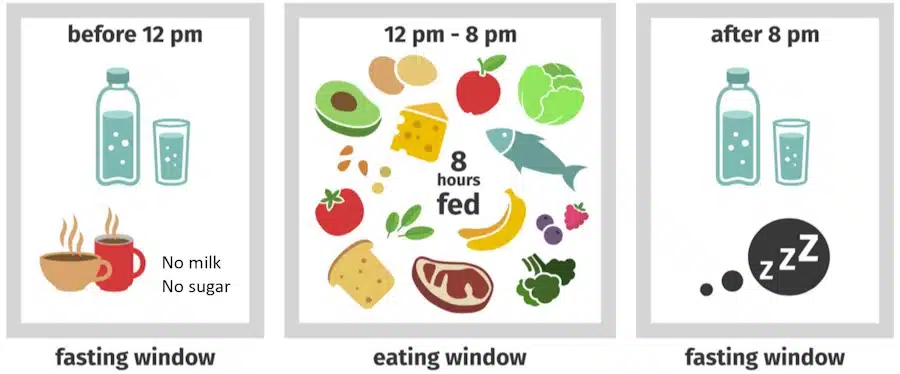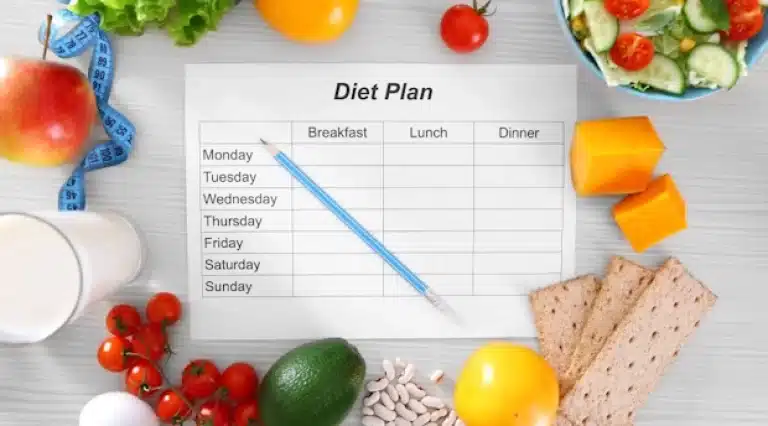
In a world filled with fad diets and quick-fix solutions, intermittent fasting has emerged as a powerful and scientifically-backed method for achieving sustainable weight loss and optimizing overall health. This revolutionary approach to eating challenges conventional beliefs about meal timing and frequency, drawing upon our ancestral roots to promote longevity and improved metabolic function.
What is Intermittent Fasting Diet
Intermittent fasting (IF) is a dietary approach that involves cycling between periods of fasting and eating. Rather than focusing on what foods to eat, it focuses on when to eat them. The concept behind intermittent fasting is that by restricting the time window in which you consume food, you can promote weight loss, improve metabolic health, and potentially gain other health benefits.
It’s important to note that intermittent fasting is not a license to overeat during the eating windows, as caloric intake still matters for overall weight management and health.
Methods of Intermittent Fasting Diet
There are several popular methods of intermittent fasting that people commonly follow. Here are some of the most well-known approaches:
1. Intermittent Fasting 16/8
This method involves fasting for 16 hours each day and restricting your eating window to 8 hours. For example, you might choose to eat between 12 pm and 8 pm, while fasting from 8 pm to 12 pm the next day. This method is often considered one of the simplest and most sustainable approaches to intermittent fasting.
2. Intermittent Fasting 5:2
With the 5:2 diet, you eat normally for five days of the week and then restrict your calorie intake on two non-consecutive fasting days. On fasting days, you typically consume around 500-600 calories. On the other five days, you eat a regular, balanced diet without any specific restrictions.
3. Alternate Day Fasting
This method involves alternating between fasting days and non-fasting days. On fasting days, you may choose to consume very few calories (e.g., 500-600 calories) or no food at all. On non-fasting days, you eat normally without any calorie restrictions.
4. Intermittent Fasting Eat-Stop-Eat Method
With this approach, you fast for a full 24 hours once or twice a week. For example, you might have dinner one day and then not eat until dinner the next day. During the fasting period, you consume no calories, but you can still drink water, tea, coffee (without sugar or cream), and other non-caloric beverages.
5. OMAD (One Meal a Day)
As the name suggests, this method involves eating only one meal within a strict one-hour eating window each day. The remaining 23 hours are spent fasting.
6. Warrior Diet
The Warrior Diet involves fasting for 20 hours each day and having a 4-hour eating window in the evening. During the fasting period, small amounts of raw fruits and vegetables, as well as protein-rich foods, can be consumed.
It’s important to note that while these methods are popular, they may not be suitable for everyone. It’s crucial to listen to your body, consider your individual needs and lifestyle, and consult with a healthcare professional or registered dietitian before starting any new dietary approach, including intermittent fasting.
How Intermittent Fasting Diet Works

Intermittent fasting works by manipulating the timing of when you eat and when you fast. The goal is to create a period of time during which your body goes without food, leading to various metabolic and physiological changes. Here’s a general overview of how intermittent fasting diet works:
1. Changes in Insulin Levels
When you fast, your insulin levels drop, which facilitates the breakdown of stored body fat for energy. Lower insulin levels also make stored fat more accessible for the body to use as fuel. This can potentially lead to weight loss and improved fat metabolism.
2. Caloric Restriction
Intermittent fasting often leads to a reduction in overall calorie intake. By limiting the time window in which you can eat, you naturally have less time to consume food, which can result in a decrease in daily caloric intake. As a result this caloric restriction can contribute to weight loss.
3. Cellular Repair and Autophagy
During the fasting period, the body activates a process called autophagy, where it breaks down and recycles damaged cells and cellular components. This cellular repair and regeneration can have various health benefits, including improved cellular function and longevity.
4. Hormonal Changes
Intermittent fasting can impact the levels of several hormones in the body. For example, growth hormone levels may increase during fasting, which can help with fat burning and muscle preservation. Additionally, fasting can affect the release of other hormones involved in hunger regulation and metabolism.
5. Enhanced Metabolic Flexibility
By regularly fasting, your body becomes more metabolically flexible. So it becomes better at switching between using glucose (from carbohydrates) and ketones (from stored fat) for energy. Improved metabolic flexibility can have positive effects on energy levels, fat burning, and overall metabolic health.
It’s important to note that while intermittent fasting can be an effective tool for weight management and potentially offer health benefits, it’s not a magic solution. It’s still essential to maintain a balanced and nutritious diet during the eating periods and to focus on overall lifestyle habits such as regular physical activity, quality sleep, and stress management.
What are the intermittent fasting rules
Intermittent fasting doesn’t have rigid rules that apply universally, as there are different methods and variations within intermittent fasting. However, here are some general guidelines that can help you get started:
1. Choose an Intermittent Fasting Method
Decide which intermittent fasting method aligns with your goals and lifestyle. Common methods include the 16/8 method, 5:2 diet, alternate day fasting, Eat-Stop-Eat, OMAD (One Meal a Day), and the Warrior Diet. Each method has its own fasting and eating windows, so select one that suits your preferences.
2. Determine Your Fasting Window
Set a specific period during which you will fast. This is the time when you abstain from consuming calories. It typically ranges from 12 to 24 hours, depending on the chosen method. For example, with the 16/8 method, you fast for 16 hours and eat within an 8-hour window.
3. Identify Your Eating Window
Determine the specific hours or time frame in which you’ll consume your meals and calories. This is your eating window. It should align with your fasting window. For example, if you choose a 16/8 fasting method and start your fast at 8 pm, your eating window would be from 12 pm to 8 pm the following day.
4. Stay Hydrated
Drink plenty of water throughout the fasting period to stay hydrated. Hydration is important for overall health and can help curb hunger pangs during fasting.
5. Choose Nutrient-Dense Foods
During the eating window, focus on consuming balanced, nutrient-dense meals that include a variety of fruits, vegetables, lean proteins, healthy fats, and whole grains. This ensures that you meet your nutritional needs.
6. Listen to Your Body
Pay attention to your body’s hunger and fullness cues. It’s essential to eat enough to satisfy your hunger and meet your nutritional needs, but avoid overeating or indulging in excessive calorie-dense foods during the eating window.
7. Be Consistent
Consistency is key with intermittent fasting. Try to stick to your chosen fasting and eating windows on a regular basis to achieve the desired results.
8. Customize to Suit Your Needs
Intermittent fasting can be adapted to fit individual preferences and needs. You can adjust the fasting and eating windows, experiment with different methods, or even combine intermittent fasting with other dietary approaches like keto or low-carb eating.
Remember, it’s important to consult with a healthcare professional or registered dietitian before starting intermittent fasting, especially if you have any underlying health conditions or are taking medications that may be affected by fasting. They can provide personalized guidance based on your specific situation.
Intermittent fasting benefits

Intermittent fasting has been associated with several potential benefits. While more research is needed to fully understand the long-term effects and individual variations.
1. Weight Loss
Intermittent fasting can help facilitate weight loss by reducing overall calorie intake. By limiting the eating window, it may lead to a natural decrease in caloric consumption, resulting in a calorie deficit and subsequent weight loss. Additionally, intermittent fasting may boost metabolism and promote fat burning.
2. Improved Insulin Sensitivity
It has been shown to improve insulin sensitivity, which is the body’s ability to effectively use and regulate blood sugar. As a result enhanced insulin sensitivity can lower the risk of developing type 2 diabetes and support better blood sugar control.
3. Intermittent Fasting Reduce Inflammation
Intermittent fasting may help reduce inflammation in the body. It is a fact that chronic inflammation is associated with various health issues, including cardiovascular disease, diabetes, and certain types of cancer. By lowering inflammation, it may have positive effects on overall health and disease prevention.
4. Enhanced Cellular Repair and Autophagy
During fasting periods, the body activates a process called autophagy, where it breaks down and recycles damaged cells and cellular components. This cellular repair mechanism may have anti-aging effects and contribute to overall cellular health.
5. Potential Cognitive Benefits
Some studies suggest that intermittent fasting could have positive effects on brain health. It may enhance cognitive function, improve memory, and protect against neurodegenerative diseases such as Alzheimer’s and Parkinson’s.
6. Cardiovascular Health
Intermittent fasting has been associated with several markers of cardiovascular health, including improved blood pressure, reduced cholesterol levels, and decreased triglyceride levels. As a result it contribute to a reduced risk of heart disease.
7. Longevity and Anti-Aging Effects
Animal studies on intermittent fasting have shown potential effects on lifespan extension and increased longevity. While further research is needed to confirm these findings in humans, intermittent fasting may have beneficial effects on the aging process.
8. Simplicity and Convenience
Intermittent fasting can be relatively simple to implement and may offer convenience for some individuals. Rather than focusing on specific food choices, it centers on when to eat, allowing for more flexibility and potentially simplifying meal planning.
It’s important to note that individual experiences and results may vary. Furthermore, intermittent fasting may not be suitable for everyone, such as those with certain medical conditions or specific dietary needs.
Is intermittent fasting healthy

Intermittent fasting can be a healthy approach to eating for many individuals. Additionally, it has gained popularity due to its potential benefits for weight loss, metabolic health, and overall well-being. Nevertheless, it’s important to note that the effects of intermittent fasting can vary from person to person, and it may not be suitable for everyone.
Here are some factors to consider regarding the healthiness of intermittent fasting:
- Individual Differences
Each person’s body and metabolism are unique, and what works for one person may not work the same way for another. It’s essential to pay attention to your body’s signals and adjust the fasting approach accordingly. - Nutritional Adequacy
It’s crucial to ensure that you are getting adequate nutrition during your eating window. A balanced and varied diet that includes nutrient-dense foods is important to meet your body’s needs for vitamins, minerals, and macronutrients. - Hydration
During fasting periods, you have to stay hydrated by consuming water and other non-caloric beverages. It is a mater of fact that proper hydration is vital for overall health and well-being. - Overall Eating Patterns
While intermittent fasting can be beneficial, it’s important to focus on overall healthy eating habits during the eating window. A diet rich in whole foods, including fruits, vegetables, lean proteins, healthy fats, and whole grains, is important for optimal health. - Individual Health Considerations
Some individuals, such as those with certain medical conditions (e.g., diabetes, eating disorders), pregnant or breastfeeding women, and individuals with specific dietary needs, may need to exercise caution or avoid intermittent fasting. Consulting with a healthcare professional or registered dietitian is recommended to determine if intermittent fasting is appropriate for your specific circumstances. - Long-Term Sustainability
The sustainability of any eating pattern is crucial for long-term success. So, it’s important to consider whether intermittent fasting is a lifestyle that you can maintain and adhere to in the long run.
As with any dietary approach, it’s advisable to consult with a healthcare professional or registered dietitian before starting intermittent fasting, especially if you have underlying health conditions or concerns. They can provide personalized guidance based on your individual needs and help you determine if intermittent fasting is a suitable and healthy choice for you.
Sample of a 7 days diet plan for the fasting diet

Here’s a sample 7-day diet plan for intermittent fasting. This plan follows the 16/8 method, where you fast for 16 hours and have an 8-hour eating window. Feel free to adjust the timing and food choices based on your preferences and dietary needs.
Day 1
| 12 pm (Break the Fast) | – Grilled chicken breast – Steamed vegetables (broccoli, carrots, cauliflower) – Quinoa or brown rice |
| 3 pm (Snack) | – Greek yogurt with berries – Handful of almonds |
| 6 pm (Dinner) | – Baked salmon – Roasted Brussels sprouts – Sweet potato |
Day 2
| 12 pm | – Vegetable omelet (made with spinach, bell peppers, onions) – Whole grain toast |
| 3 pm (Snack) | – Apple slices with almond butter |
| 6 pm (Dinner) | – Lean turkey or chicken stir-fry with mixed vegetables – Cauliflower rice |
Day 3
| 12 pm (Break the Fast) | – Overnight oats with chia seeds, almond milk, and berries |
| 3 pm (Snack): | – Celery sticks with hummus |
| 6 pm (Dinner): | – Grilled shrimp skewers – Quinoa salad with mixed greens, cucumber, cherry tomatoes, and lemon dressing |
Day 4
| 12 pm | – Avocado toast on whole grain bread with sliced tomatoes and a sprinkle of feta cheese |
| 3 pm | – Greek yogurt with a drizzle of honey and sliced almonds |
| 6 pm | – Baked chicken thighs with roasted asparagus – Quinoa or brown rice |
Day 5
| 12 pm | – Spinach salad with grilled chicken, cherry tomatoes, cucumbers, and balsamic vinaigrette |
| 3 pm | – Hard-boiled eggs |
| 6 pm | – Grilled steak with roasted vegetables (zucchini, bell peppers, onions) |
Day 6
| 12 pm | – Quinoa bowl with black beans, corn, avocado, and salsa |
| 3 pm | – Sliced bell peppers with guacamole |
| 6 pm | – Baked cod with lemon and herbs – Steamed broccoli – Quinoa or brown rice |
Day 7
| 12 pm | – Vegetable and chickpea curry with brown rice |
| 3 pm | – Mixed berries with a dollop of Greek yogurt |
| 6 pm | – Grilled tofu or tempeh with stir-fried vegetables (broccoli, mushrooms, snap peas) – Cauliflower rice |
Remember to drink plenty of water throughout the day and listen to your body’s hunger and fullness cues. Additionally, feel free to incorporate herbal tea or black coffee (without sugar or cream) during the fasting period to help curb hunger. Adjust portion sizes and specific food choices based on your individual needs and preferences.
Summary
The Intermittent Fasting diet represents a fascinating and scientifically-grounded approach to reimagining our relationship with food and achieving holistic well-being. Its versatility, potential benefits, and adaptability to individual lifestyles have contributed to its increasing popularity among health-conscious individuals.
However, it is crucial to approach intermittent fasting with mindfulness, especially for women and those with specific medical conditions.
By embracing intermittent fasting as a sustainable lifestyle choice rather than a temporary fix, we have the opportunity to unlock a balanced, revitalized version of ourselves while promoting long-term health and vitality.